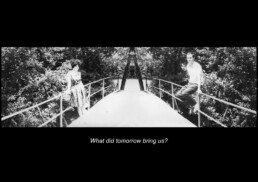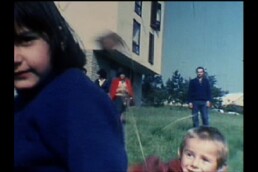DEJAN KALUDJEROVIĆ (1972)
What Did Tomorrow Bring Us?
slide projection with sound
variable dimensions
edition: 2/5
2011
1st of May 1977
two-channel sound installation
13’15”
2014
What Did Tomorrow Bring Us?
slide projection with sound
variable dimensions
edition: 2/5
2011
The installation What Did Tomorrow Bring Us? is a slide projection of photographs of the artist’s parents, accompanied by the sound of a flowing river. The projection consists of two merged photographs. One shows the artist’s mother, photographed by her husband and in the other is the father, photographed by his wife. Joining them into one whole, he connects the documentary with a construction, the present with the past. The grammatically distorted chronology of the work’s title suggests the collapsing of the past, present and future, inviting the viewer to examine the authenticity of both the question and the projection.
The work deals with the relationship between the present and the past through the image of a couple and the paradoxical question of what tomorrow brought to us. It also speaks of a particular historical period of Yugoslavia and can be understood as an allusion to the socialist and communist dream lived by the artist’s parents. “Frozen” in the picture at one particular moment, the man and the woman wonder about the future directly from their past. Although the picture seems to invite us to cross the bridge on which the couple is, the text becomes a physical obstacle for us to do so. The man’s and woman’s glances meet with the glances of the viewers and remain trapped between the mutual process of thinking and the presence of outsiders.
© Cultural Centre of Belgrade, October Salon Collection and the artist
Gift Contract: III-5-38/15.3.2014.
Inventory No. 1340
Photo: still from the video work, courtesy of the artist
Selected Bibliography:
Branislav Dimitrijević, ‟We might come from Hell, but we’re too young to tell”, Can I Change My Career For a Little Fun?, Museum of Contemporary Art, Belgrade, Belgrade, 2007, 5–10
Kristina Marberger, ‟What Did Tomorrow Bring Us?”, accompanying text for the exhibition What Did Tomorrow Bring Us?, HDLU-Karas, Zagreb, Croatia, 2012
Goran Petrović, “Nemogući identitet i nestabilnost reprezentativnih formi u radu Dejana Kaludjerovića”, Art Centrala Magazine, Podgorica, 2014, 8–9
Marina Martić, “The Kids Are Alright”, Dejan Kaludjerović, Conversations –Azerbaijan, YAY Gallery, Baku, Azerbaijan, November 2014, 11–13.
1st of May 1977
two-channel sound installation
13’15”
2014
It is a deconstruction of a family film depicting an act of violence whose cause remains unknown. It focuses on a scene where a boy is throwing a rock at a girl. The artist analyses the event from his early childhood and invites his family members to recall the event.
The work was exhibited at the 55th October Salon, and received the October Salon Award.
The original recording was divided and transferred onto 80 slides, which are repeated every four minutes, thus emphasizing the scene of violence and extending its duration. The other important segment of the installation is audio recording, the testimonies of the eyewitnesses (family members), who are talking about the event that took place in 1977. The differences in their statements testify to the subjective nature of memories and observations, which becomes evident to the viewers themselves in the process of understanding the work. The work was presented in two separate rooms: in one, audio-recordings of the eyewitnesses’ testimonies were heard, and in the other, the picture of the act of violence was shown. In this way, the artist leaves room for each viewer individually to create their own parallel scenario of the event – which itself is disputable.
The work was exhibited at the 55th October Salon: Disappearing Things, 2014
© Cultural Centre of Belgrade, October Salon Collection and the artist
Purchase Contract: III-5-420/16.12.2016.
Inventory No. 1426
Photo: still from the video work, courtesy of the artist
Selected Bibliography:
55th October Salon, Disappearing Things. Cultural Centre of Belgrade, 2014
Seamus Kealy, ‟Repositories of Unseen Impulses: A Few Notes on the Work of Dejan Kaludjerović”, Conversations, Verlag Für Moderne Kunst, Vienna, 2017, 33–39
Goran Petrović, Impossible Identity and Instability of Representational Forms in the Work of Dejan Kaludjerović, The Future Belongs to Us?, Galerie Van De Weghe, Antwerp, 2013
Walter Seidl, “Dejan Kaludjerović: Realities of a Child’s Mind” Can I Change My Career For a Little Fun?, Museum of Contemporary Art Belgrade, Belgrade
О АУТОРУ:
Dejan Kaludjerović (1972, Belgrade, Serbia) graduated and received his master’s degree from the Faculty of Fine Arts in Belgrade, and completed his specialist studies at the Academy of Applied Arts in Vienna. In 2010, the Austrian government awarded him honorary citizenship for deserving artists/citizens. In his work, Kaludjerović most often questions responsibility and manipulation, as well as the way mass media, education systems, or family contexts affect the society. His work often focuses on the exploration of the dominant central image of Western society, obsessed with violence, as well as on the structures and mechanisms of capitalism. His works are part of many private and public collections; he has exhibited at numerous solo and group exhibitions in Europe, America, Australia and Asia. He lives and works in Belgrade and Vienna. More information at dejankaludjerovic.net

